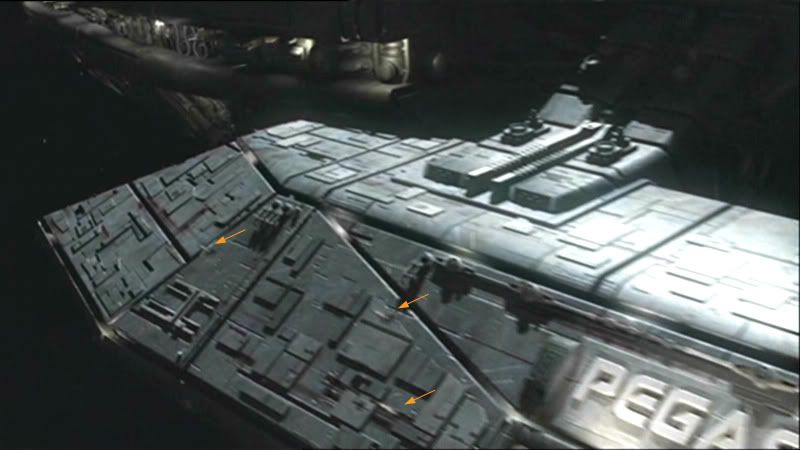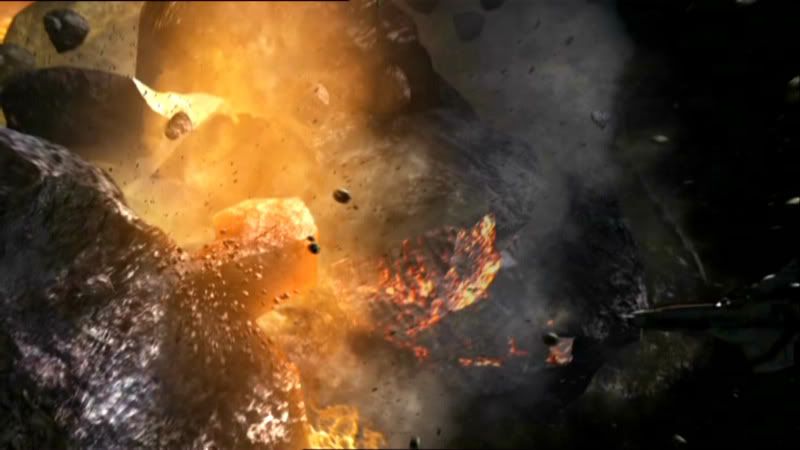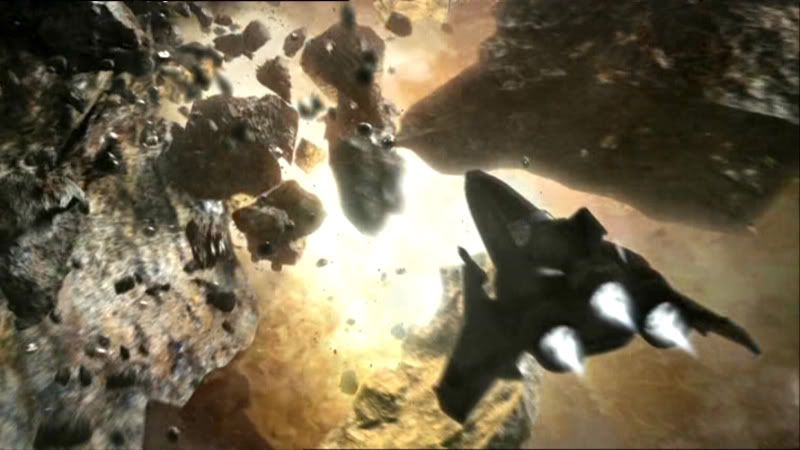Mike DiCenso wrote:
Nice try, but have you seen this episode? The Pegasus is already some time into combat with Cylon basestars when Lee takes command and orders the above.
Mr. Oragahn wrote:
There's no proof any solution was prepared before the order was given. For all evidence accounted, Garner didn't give any order of that vein, and once Adama passed his, he clearly said to have a solution stand by for firing.
After a few seconds, the battery had several rounds ready for a salvo. That prep would have been non existent if the rounds were already prepared before hand. He'd just have ordered the ship to fire from the get go.
There's a massive difference between ordering a
firing solution and
preparing the guns themselves for firing. In Star Trek it's the difference between a captain ordering the phasers and photon torpedoes armed on Red Alert, and then actually having the tactical officer target a specific ship, or specifc targets on said ship.
Now it's possible that the Pegasus is somewhat faster at arming than the Galactica due to the greater use of automation, but from what I've seen, that doesn't necessarily apply to the nukes, which as shown in "The Eye of Jupiter", is an arming procedure akin to our current-day nuclear missle launch protocols.
I haven't seen EoJ, and limiting my exposure to spoilers, I'll try to get an answer as simple as possible. Was it the Galactica arming those nukes?
Plus as you said, automatised systems can help. The Pegasus could be 30~35 years younger than the Galactica. That's a lot of time to improve systems, especially over ships which were non reliant on computers, especially networked computers.
Yes. The
Pegasus is long destroyed by the time of EoJ. And I've already admitted to the possibility of the
Pegasus have a faster reaction time. That being said, the Galactica has to arm and bring the missle silos and launchers on-line as part of the bluff to destroy the Temple of the Five as well as the Eye of Jupiter (artifact) itself.
I'am trying to find a picture on Sci Fi Flare or the Battlestar Wiki of the launch prep for the missles. The best I can do so far is the initial opening of the tubes:
http://en.battlestarwiki.org/wiki/Image ... tubes1.jpg
There is also this shot of the missles being moved into position on the launcher rails out of the silos:
http://en.battlestarwiki.org/wiki/Image ... tubes1.jpg
The Battlestar Wiki entry:
http://en.battlestarwiki.org/wiki/Image ... tubes1.jpg
There are twelve missles in all.
The discription of the launch authorization procedure:
Nuclear Ordnance
Nuclear Groundstrike Missiles being moved into firing positionWith nuclear ground strike missiles loaded in the tubes and ready to launch with the appropriate target information, the command authority must then specifically authorize the release of such weapons.
Following authorization, the safety protocols on both the launch systems and the warheads themselves are disabled by the Tactical Officer, following the CO's order.
The two most senior officers aboard ship, usually the Commanding Officer and the Executive Officer, then input their firing codes. The final stage is for the firing key to be inserted into the master control console and turned, thus initiating the launch sequence. The order to fire is given by the CO.
After all, a Mercury class is twice bigger than the Galactica, but only need half the crew.
This explains the efficiency.
Not necessarily. The launch authorization procedures as described above show that automation only goes so far here. Also note again the launch authorization parallels to our modern day nuclear strike authorization procedures.
This is not just a "push button" affair.
Has it been proven? The times the Galactica was dramatically damaged, wasn't it because of basestars' heavy fire?
Actually, in the mini-series, the
Galactica's port flight pod is suffers heavy damage to the forward section (the ship is nearly lost due to the secondary effects from the internal fires and such) from the nuke launched by a mere Cylon raider, and suggesting strongly that a hit by a 50 kt nuke is sufficent cause dangerously threatening damage to a battlestar.
Ah, yes, I remember. A port side which lacks the external layers of armor, and which the exposed structure can be destroyed from the inside by a mere pack of C4 (Water).
Not really. Part of the area struck has a fair amount of armor covering the upper surface. The roughly 40 x 100 meter section right below the ship's name plate still bears the blackened scar from the nuke blast. Take a look this overhead image of the port flight pod (still pristine in this image):
http://media.battlestarwiki.org/images/8/8b/Hanger.JPG
We're not talking about a younger and fully armoured warship.
Maybe. But the
Galactica was stated to be enough on her own to still be able to seriously damage the
Pegasus, and leave her vunerable to Cylon attack. The Big G maybe older, but she still is quite capable and comparable. A raider launched kilotons yeild nuke can threaten a battlestar, if it should get past the flak gun screen.
Actually, the explosion geometries will likely send the energies out over a much wider surface area than the concentrated beam of a phase cannon.
Not that much for a point impact
Given what we see of the big G's flight pod damage. The explosion covered a roughly 40 x 100 meter elliptical area (I'am actually undersizing the blast damage some given the size of the 615 m long flight pod). But give that, a 40 x 100 area would give us 4,000 meters square surface area "burned" by the 50 kt nuke. That's 210,000 gigajoules divided by 2 (only half the explosion will go to the big G flight pod), then spread the remaining 105, 000 GJ over 4,000 square meters, or 26.25 GJ per meter square.
Now an NX class phase cannon on overload can manage about 5 TJ per meter^2, or 120 times more energy delivered to the armor than the nuke. The NX-01 could, in theory, drill through the
Galactica's armor, if not the
Pegasus'.
Also the nuke explosion will be over in a few seconds at most, while phase cannons can be made to dwell on the targeted area for as long as necessary. So you really would have from a nuke bomb of 50 KT something like 2.1 TJ per meter square, whereas the NX-01 would be able to concentrate up to 5 to 10 TJ per meter^2, and remember a phase cannon beam can dwell on a spot.
The fact that the nuke explosion will happen within a fraction of a second will actually mean much more power than a Trek canon. The yield is not all.
Yes, there is that. But the explosion will be gone in a fraction of a second. As I calculated above, 26.25 GJ is the energy actually being delivered. So really, 1/100th of a second will mean 2.25 TW, which will be gone seconds. The phase cannon beam, on the other hand, can continously fire, and dwell on a specific spot.
But this is the NX-01 merely trying to "brute force" it's way past armor, which is a waste of time. Firing at specific targets with a mind to disabling the
Pegasus is the more logical way to go, and the NX-01's sensors, dispite being more primitive than the other Trek series' ships, still can read weapons and other specific potential targets.
No need. There are clearly three fighters (in the triad formation) that are about to enter the landng bay. Just simply watch the episode "The Pegasus" to see for yourself.
+
They are landing, or about to. Just watch the episode.
Nice bluff, but you hardly convince that you watched it at all.
I have the episode on DVD. I have the sequence taken in cap by wiki.
There's no any single fighter about to land at all.
As I said, they're even smaller than fighters located closer to the Pegasus. Even without the video, it's simply geometrically
impossible for that triad of Vipers to be about to land, when there are other Vipers, further away from the camera, visible with the Pegasus' nacelle beyond them in the background, and they're cleary not fused into the Pegasus.
So my point stands. Wiki is talking crap, I have all the episode at hand and there's nothing such as Vipers about to land in that sequence.
You're not even willing to prove wiki's absurd claim, so let's look at screencaps I took to put it to rest once and for all:
I did. I simply asked you to go look at the episode. There are three vipers which turn on axis after the intial encounter. They then face right at the opening, and start inside before the jump cut.
Fighters flying before the portside nacelle:
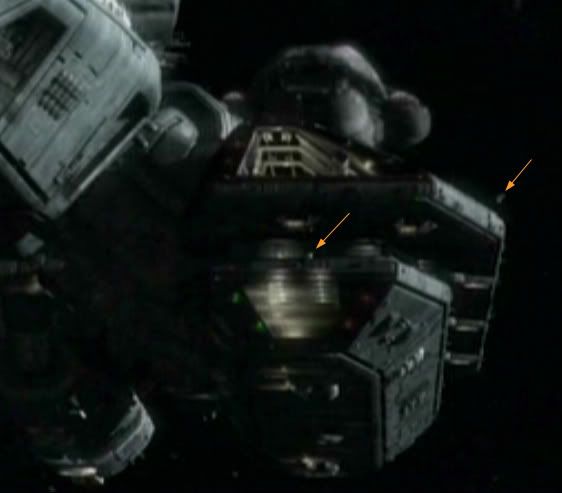
Fighters flying along the nacelle's stern:

Compared to wiki's BS about fighters landing:

So now, let's look again at the cap of the cylon nuke and really think about its size:
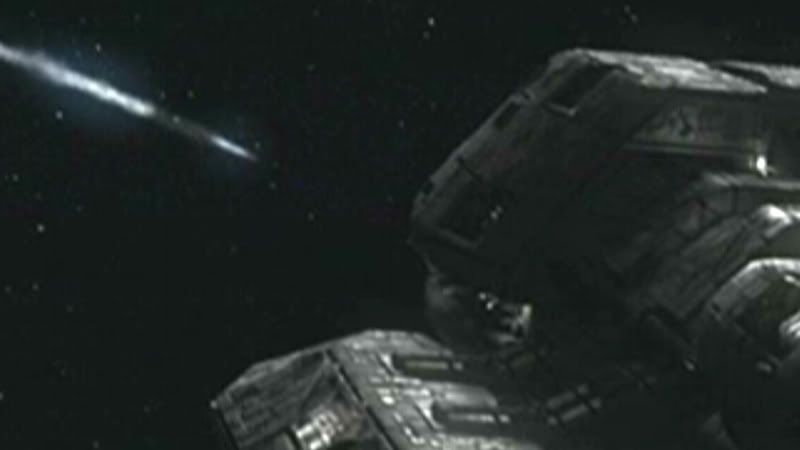
You can't hotlink like that. That's why I don't do that from that and certainother websites. Anyway, even if we go with your scaling, how does that help your case for megaton-level nukes?
We don't know what they use as a warhead component, and if tylium is used for the first stage, it will work nice. Plus we don't know how long it takes for tylium to become inert. For all we know, it could be a chain reaction triggered by the hard radiation, not something immediate, so tylium could be part of the final stage of a heavy warhead's reaction.
We do know for sure that plutonium is a critical component of the
The plutonium could only be a stage of the reaction mechanism(s). Tylium could be part of initial stage within the warhead, or part of a late stage, but the reaction would be so fast that the refined ore wouldn't have time to turn inert.
Yet there is no mention of any such technique, ala a staged fusion nuke for such a warhead.
There's no lack of such either, so there's plenty of room left to wiggle with largely plausible theories.
Ok. I got lost on
your calc one page ago.
4.2 was for a duration?
What's the best resistance the hull can come with once polarized?
We don't know. The NX class has stayed in long firefights with the superior Klingon and Vulcan ships, but that doesn't tell us much since the those vessel's beam weapon firepower has never been quantified the way the NX class has. We just know that they are much more powerful.
How do we know that?
Because it has been stated and shown over and over that Vulcan and Klingon technology is generally much better than Earth 22nd century tech. The Klingons in "Judgement" even consider the NX-01's phase cannons as "Low-yield particle cannons".
Except that that universe isn't canon. The Mirror-NX-01 is. :-)
There's an infinite amount of universes I suppose, so mine can only be as canon as any variant shown onscreen.
That said, it's clear we're not fiddling with altverses.
Ah, no. This is about what is established in the stories, and there are no alternate universe nBSG stories. But there are plenty of ST Mirror universe stories. However, to avoid complications, I'll go with the presumption that this is the regular universe, peace and exploration NX-01.
There are many weapons to disable, and the NX won't have time to aim at all the launching tubes. The crew would first need to know where they are to boot.
The flack weapons are not a serious threat. They're purposes is to provide defense against missle and fighter attack. The bow guns would be a primary target, as would the missle silos themselves.
They'd have to wait for salvos to be fired before they'd know where they are.
If the missles should be launched before they can be destroyed, then the NX-01 jumps to warp and stays there for a while while the missles fly around uselessly until fuel exaustion, then the NX jumps back to sublight and continues attacking, or attacks from warp.
Attack from warp. Please prove it's a natural tactic, especially when it should be useful to the NX-01 when it's in great danger.
Not terribly useful when other starships can follow you into warp. The tactic works best when you are up against an opponent who cannot do that, as happened in TOS' "Elann of Troyius":
http://www.st-v-sw.net/STSWwarpturn.html
That said, the Pegasus jumps away (like 40 LY in less than two minutes), and repairs itself, and both ships loose contact and it's a draw.
Yes, a draw is also possible.
Except that phase cannon beams do not seem to work that way. They are particle beam weapons, not LASERS.
That's just going to be particles sent into ejected plasma. How's that supposed to arrange anything?
Because the beam could remain more coherent and become less dispersed than a laser. The forward phase cannon batteries firing at a large asteroid while the ship is in the accretion disk:
http://ent.trekcore.com/gallery/display ... 69&pos=559
Note all the gas and debris, and yet the phase cannon beams remain fine and effective. The rock after being shattered:
http://ent.trekcore.com/gallery/display ... 69&pos=560
http://ent.trekcore.com/gallery/display ... 69&pos=561
No problems there.
Were I in command of an NX, I would be targetting the launch and landing bays ASAP. They engines also are potentially vunerable to having a photonic torpedo or two sent "up the tailpipe" as well, thus bypassing the armor, if need be.
Vipers can intercept them. Flak can shoot them down. Ejecta may even burn them.
Photonic torpedoes are not the same as BSG missles or the older ST:ENT Triton class spatial torpedoes. They are an early form of photon torpedo, and may even have their own form of shielding as evidenced by their glow:
http://www.st-v-sw.net/STSWtorpsh.html
There is no such episode, Oragan. You mean "In Mirror, Darkly, Parts I & II" with the Constitution class Defiant being used to plummel the far less advanced ships of the Tholians and Rebel fleet? Do you mean the Mirror NX-01 getting hit because it was trapped in the Tholian's web, rendering it largely helpless?
I'm talking about that episode where there's a bipedal lizard in the Enterprise, and where in the end, a Kirkized Archer is killed drinking poison after having sex with the asian chick.
It's from the episode for which you even linked to screencaps.
That's IaMD part 2 you're talking about. What "naval tactics" are you talking about about?
The NX-01 has the advantage of a lesser profile, far more agility and advanced weaponry. However, it's still weak in the light of colonial nukes, and one single glancing hit would be bye bye for the Trek ship.
You still have not proved that the Colonials have any such nukes that they can deploy so quickly, and polarizing the hull does not take very long at all. Since the NX-01 has been in close proximity to a black hole and survived ("Singularity" ST:ENT2), I don't think the tac nukes of the Colonials will be a serious problem with just mere "glancing blows".
Proximity to a black hole means jack until you get a good estimate of the distance and the radiations. Unless you're talking like critically close to the accretion disk, this is dismissable.
As for deployment, again, it doesn't seem to take that long, besides a few seconds, to get weapons ready for standby, and if that's a real problem, the Pegasus has enough armor to withstand the NX-01's attacks to get nukes ready.
Here is the NX-01 approaching the black hole early in the episode:
http://ent.trekcore.com/gallery/display ... m=69&pos=1
The projected flight path:
http://ent.trekcore.com/gallery/display ... 69&pos=458
Later when they are flying through the debris laden acccretion disk:
http://ent.trekcore.com/gallery/display ... 69&pos=490
http://ent.trekcore.com/gallery/display ... 69&pos=491
http://ent.trekcore.com/gallery/display ... 69&pos=493
And what are the nukes supposed to be safe an advantage then? How are they supposed to destroy the NX-01? With frakin' harsh language maybe?
Btw, you say polarized hull. Are all surfaces polarized? What about those multiples windows? What about the nacelles themselves, or the impulse engines? Are you telling me that they have glass that can resist this kind of damage:
The nukes are there for planetary bombardment. The fighter carried nukes are for attacking a captial ship en masse, and providing a screen should large nukes be deployed or to defend against fighters carrying nukes (as was shown in the mini-series).
The windows and all other surfaces seem to also be polarized as well. The open impulse engine exaust ports are not, but those are very small targets, and it would probably take a very dedicated attack by the vipers to get a hit inside them.
-Mike


